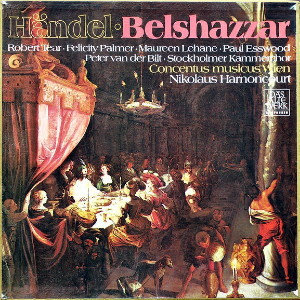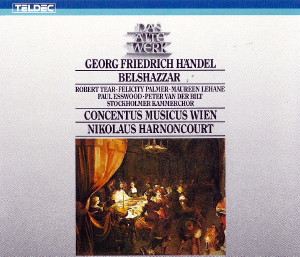 |
4 LP -
6.35326 FL - (p) 1976
|

|
| 3 CD -
8.35326 ZB - (c) 1985 |
|
Georg Friedrich
Händel (1685-1759)
|
|
|
|
|
|
|
|
| Belshazzar - Oratorium
(Text: Charles Jennens) |
|
|
|
|
|
|
|
| Ouverture |
|
4' 31" |
A1 |
Act 1
|
|
|
|
| Scene 1 |
|
15' 17" |
|
| - Vain fluctuating state -
(Nitocris) |
5' 04"
|
|
A2 |
| - Thou, God most high |
4' 05"
|
|
A3 |
| - The fate of Babylon |
1' 19" |
|
A4 |
| - Lament not thus - (Daniel) |
4' 49" |
|
A5 |
| Scene 2 |
|
25' 59" |
|
- Behold, by Persia's hero made
- (Chorus)
|
2' 56" |
|
A6 |
- Well may they laugh -
(Gobrias)
|
1' 28" |
|
B1 |
| - Opprest with never-ceasing
grief |
3 08" |
|
B2 |
| - Dry those unavailing tears -
(Cyrus) |
2' 37" |
|
B3 |
| - Be comforted |
4' 07" |
|
B4 |
| - Behold the monstrous human
beast - (Gobrias) |
3' 15" |
|
B5 |
| - Can you then think - (Cyrus) |
4' 49" |
|
B6 |
| - All empires - (Chorus) |
3' 39" |
|
B7 |
| Scene 3 |
|
12' 55" |
|
| - O sacred oracles - (Daniel) |
5' 16" |
|
C1 |
| - Rejoice, my countrymen |
3' 07" |
|
C2 |
| - Sing, oh ye heav'ns - (Chorus) |
4' 34" |
|
C3 |
Scene 4
|
|
31' 58" |
|
| - Let festal joy - (Belshazzar) |
4' 54" |
|
C4 |
| - For you, my friends |
1' 01" |
|
C5 |
| - The leafy honours - (Nitocris) |
8' 16" |
|
C6 |
| - It is the custom -
(Belshazzar) |
1' 54" |
|
D1 |
- Recall, oh king - (Chorus)
|
2' 59" |
|
D2 |
| - They tell you true -
(Nitocris) |
1' 36" |
|
D3 |
| - Oh dearer than my life -
(Nitocris, Belshazzar) |
6' 42" |
|
D4 |
| - By slow degrees - (Chorus) |
4' 36" |
|
D5 |
Act
2
|
|
|
|
| Scene 1 |
|
12' 18" |
|
| - See, from his post - (Chorus) |
6' 23" |
|
E1 |
| - You see, my friends - (Cyrus) |
5' 25" |
|
E2 |
| - To arms, to arms - (Chorus) |
0' 30" |
|
E3 |
Scene 2
|
|
25' 41" |
|
| - Ye tutelar gods - (Chorus) |
2' 55" |
|
E4 |
| - Let the deep bowl -
(Belshazzar) |
5' 46" |
|
E5 |
| - A Sinfony |
2' 41" |
|
F1 |
| - Oh misery - (Chorus) |
1' 32" |
|
F2 |
| - Oh king - (Nitocris) |
1' 43" |
|
F3 |
| - No! to thyself - (Daniel) |
4' 41" |
|
F4 |
- Regard, oh son - (Nitocris)
|
6' 23" |
|
F5 |
| - Oh God of Truth - (Cyrus) |
5' 37" |
|
F6 |
| - Oh glorious prince - (Chorus) |
4' 46" |
|
F7 |
| Act 3 |
|
|
|
| Scene 1 |
|
10' 30" |
|
| - Alternate hopess and fears -
(Nitocris) |
4' 22" |
|
G1 |
| - Fain would I hope - (Nitocris,
Daniel) |
2' 19" |
|
G2 |
| - My hopes revive |
2' 14" |
|
G3 |
| - Bel bowweth down - (Chorus) |
1' 35" |
|
G4 |
| Scene 2 |
|
2' 13" |
|
| - I thank thee, Sesach |
2' 13" |
|
G5 |
| Scene
3 |
|
20' 19" |
|
| - To pow'r immortal - (Gobrias) |
2' 14" |
|
H1 |
| - Be it thy care - (Cyrus) |
3' 00" |
|
H2 |
| - Great victor - (Nitocris,
Cyrus) |
5' 14" |
|
H3 |
| - Say, venerable prophet -
(Daniel) |
0' 48" |
|
H4 |
| - Tell it out - (Soli and
Chorus) |
3' 31" |
|
H5 |
| - I will magnify thee |
5' 32" |
|
H6 |
|
|
|
|
Robert Tear,
Belshazzar, König bon Babylon, Tenor
|
|
Felicity Palmer,
Nitocris, Belshazzars Mutter, Sopran
|
|
Maureen Lehane,
Cyrus, Fürst der Perser, Alt
|
|
Paul Esswood,
Daniel, ein jüdischer Prophet, Alt
|
|
| Peter van der
Bilt, Gobrias, ein zu Cyrus
übergegangener Assyrer, Baß |
|
| Thomas Sunnegårdh,
Arioch, ein babylonischer Hofmann, Tenor |
|
| Staffan Sandlund,
Ein Bote, Baß |
|
|
|
| Stockholmer
Kammerchor / Eric Ericson, Leitung |
|
(Chur der
Babylonier)
|
|
| Continuo:
Herbert Tachezi, Cembalo /
Nikolaus Harnoncourt, Violoncello |
|
|
|
CONCENTUS MUSICUS WIEN (mit
Originalinstrumenten)
|
|
| -
Hermann Schober, Naturtrompete in
D |
Mitglieder des
"MUSICA HOLMIAE" |
|
| -
Richard Rudolf, Naturtrompete in
D |
-
Lars Fryden, Violine |
|
| -
Kurt Hammer, Pauken |
-
Tullo Galli, Violine |
|
| - Jürg Schaeftlein,
Oboe |
-
Bertil Orsin, Violine |
|
| -
Paul Hailperin, Oboe |
-
Lennart Fredriksson, Violine |
|
| - Alice Harnoncourt,
Violine |
-
Bengt Ericson, Violoncello
(Chöre) |
|
| -
Peter Schoberwalter, Violine |
-
Göte Nylén, Violone (Chöre) |
|
| - Wilhelm Mergl,
Violine |
-
Anders Öhrwall, Orgel |
|
| -
Elizabeth Wilcock, Violine |
|
|
| -
Anita Mitterer, Violine |
|
|
| - Walter Pfeiffer,
Violine |
|
|
| - Ingrid Seifert,
Violine |
|
|
| -
Veronika Schmidt, Violine |
|
|
| -
Richard Motz, Violine |
|
|
| -
Josef de Sordi, Violetta |
|
|
| -
Kurt Theiner, Viola |
|
|
| -
Nikolaus Harnoncourt, Tenorviola
(Chöre), Violoncello (Arien,
Recit.) |
|
|
| -
Friedrich Hiller, Violoncello |
|
|
| -
Eduard Hruza, Violone |
|
|
| -
Jonathan Cable, Violone |
|
|
| -
Milan Turkovic, Fagott |
|
|
| -
Herbert Tachezi, Cembalo |
|
|
|
|
| Nikolaus Harnoncourt, Gesamtleitung |
|
|
Luogo e data
di registrazione
|
| 1976 |
|
Registrazione
live / studio
|
| studio |
Producer / Engineer
|
| - |
Prima Edizione
CD
|
Teldec "Das Alte Werk" -
8.35326 ZB - (3 cd) - 58' 58" + 58' 28"
+ 56' 26" - (c) 1985 - AAD
|
Prima
Edizione LP
|
Telefunken "Das Alte Werk" -
6.35326 FK - (4 lp) - 46' 14" + 35' 26"
+ 38' 21" + 43' 54" - (p) 1976
|
|
|
Remarkes on
the performance
|
Orchestral setting:
Except for the continuo instruments,
the composition of the
orchestra can be recognized from Handel's
scoring: strings (occasionally
with thrice divided violins), two
oboes, bassoon, two trumpets and
kettledrums. In accordance with
performance practice at that time it
can be assumed that final
instrumentation was determined at the
particular performance and thus was
not a part of the composition, but of
the performance. Thus, for example,
the role of the woodwind in tutti
pieces depended upon the spatial
conditions, the size of the string
setting, the emotional substance of
the piece, the key and the tonal
range. In this rendering some pieces
were played with augmented oboes, a
method which is probably only
advisable in performances with Baroque
instruments since the latter, as
opposed to those used today,
completely fuse with the string sound.
The trumpets, however, should only be
played in the places stated, as they
engender very strong associations
(war, royal rule, divine rule),
outside of which they were never
permitted to be used.
A large number of instruments could be
used for the continuo: harpsichords,
organs, harps, chitarroni,
lutes etc. - We have employed only
harpsichord and organ together and
alternately in order to support the
dialogue and the "affections" also
from the point of view of tone.
Notation: Handel wrote for the
musicians of his day, and they were in
the habit of playing a creative part
during performance rather than
reproducing as accurately as possible
the precisely noted text. For instance
dotted rhythms would have meant for
the musicians of that time merely that
one note had to be long and the other
short; long and short had to be
concluded from the context. The dot
after a note would normally have been
performed like a pause. Tempo marks
were hardly necessary because the
tempi are fairly clearly evident from
the movement form, the bar indication,
the short note values and the affection
of the piece, in conjunction with the
scoring and the acoustics of the place
of performance. Similarly the composer
had to include dynamic marks only in
exceptional cases, because the broad
surface dynamism did not have that
enormous significance as in music
after Beethoven (in many cases forte
and piano can he exchanged without any
loss in substance). However, the
decisive and highly important minor
dynamics [from the stimulation of
single notes to the designing of
polyphonic figures)
were well known to every
musician and in their relationship to
language were so natural that this did
not have to be written down. - These
preconditions were to be reestablished
with our performance. How long a note
is to be effectively
sustained cannot automatically be
construed from the written music in
Handel's case without
knowledge of the
principles of his performance
practice. Very freqently, especially
in secco recitatives, the notes have
to be decisively shortened and
orthographically correct rhythms
musically transformed. The illusion as
a most important aspect of listening
to music, that is to say the
imaginative hearing of sounds which
are neither played nor sung, is of the
greatest significance for the music of
the 17th and 18th centuries.
Handel expected of his rnusicans a
large degree of creative imagination,
since he reckoned with embellishments,
especially in the repetitions.
However, these are only interesting
and convincing if spontaneously
invented and not arduously prepared;
an especial and essential charm is
their uniqueness. For this
reason we have kept such
embellishments to a minimum, since
their fixation in repeatable form to
an excessive degree would make
listening to a gramophone record an
irritating experience.
It has lately become fashionable to
vest a particular abundance of ideas,
wit and imagination in the continuo
parts of harpsichord and organ. When
heard superficially
this style of play always enjoys
considerable praise, and occasionally
it is even lauded as being especially
stylistic. But the continuo
instruments are by no means a
playground for ideas; in a simple and
refined manner they
should provide the harmonious and
rhythmic support. They should never
be conspicuous - either from
superabundance or unfeeling plodding.
There is still a great
deal to be discovered here in the
performance practice of older music.
Articulation: Handel very
seldom wrote articulation signs. His
musicians were well acquainted and
took for granted the principles
according to which, say, pages of
semiquaver chains were to be
transformed into speaking figures
by way of ingenious ties and points of
emphasis. We too have endeavoured to
accord with these principles.
Nikolaus
Harnoncourt
English
translations by Frederick A.
Bishop
|
|
Nikolaus
Harnoncourt (1929-2016)
|

|

|
|